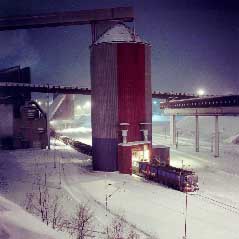The weighing system weighs the train or its
load while the train is in motion.

The weighing
system can also be used for calculating the number of
passengers in carriages and for loading systems with automatic
feedback to ensure that the load will be as optimized as
possible.
The installation work is simple and can
normally be done without interrupting traffic and is of a
pitless weighbridge type. The only work
that needs to be done on the track is to drill holes for the
sensor mounting bolts and to install cable conduit tubes in
the railway line embankment.
The weighing system can
be used in three ways, i.e. standing alone, connected to a
network or to a weighing system server. Weighing can be done
fully automatically and can be initiated from a signal box, for
example. The weighing results can then be transmitted to
predetermined recipients by the network. Weighing can also be
initiated manually.

On connection to a train
data system or if the train is weighed before and after
loading, the net weights of the wagons can be calculated, and
invoicing documentation can then be sent to predetermined
recipients.
The weighing system is quality assured and
is tested in cooperation with the Swedish National Testing and
Research Institute (SP) and the Norwegian Metrology
Accreditation Service (Justervesenet). Approval has been
obtained for use within the speed range of 4 - 25 km/h in
accordance with OIML R106, Class 1.
Wayside analyze computer software can
calculate net, tare and gross weight, out of balance axle load,
bogie load, front/rear load, left and right side load and detect
unadjusted bogies.
The system is able to measure when values
exceed preset thresholds and alarms could be sent to those
responsible.
It is importand to detect faulty loads to
prevent derailments, wheel bearings failure caused by overload,
breakage of the rail and to reduce the maintenance cost of
vehicles and tracks.